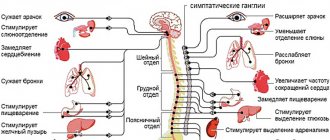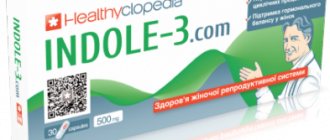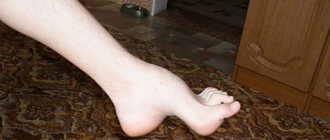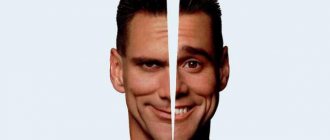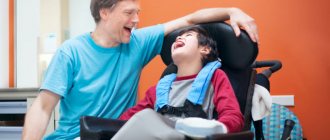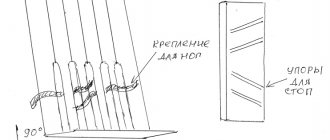Key Facts
Muscular dystonia is a syndrome characterized by slow or repeated fast movements causing rotation, flexion or extension of the trunk and limbs with the formation of pathological postures.
A characteristic feature of dystonic hyperkinesis is the occurrence or intensification of voluntary movements. Dystonic posture initially occurs only with a certain movement, but gradually becomes permanent, remaining at rest. Another feature of dystonia is the dynamism of hyperkinesis: improvement after sleep, the influence of certain “corrective gestures” and changes in posture, the influence of the emotional state.
Read also
Hyperhidrosis
Hyperhidrosis is a condition that is manifested by excessive, inadequate sweating due to increased activity of the sweat glands.
It happens that a person sweats so profusely that his clothes get wet very quickly, from his hands… Read more
Treatment of spasticity
Spasticity is an excessive increase in muscle tone, the cause of this condition can be a stroke, traumatic brain injury, spinal injury, spinal cord problems, neuroinfection, multiple…
More details
Facial hemispasm
Facial hemispasm is a forced contraction of the facial muscles of one half of the face. Most often, the orbicularis oculi muscle is first involved in the process, then the muscles of the lower half of the face join.…
More details
Blepharospasm
Blepharospasm is a chronic disease characterized by involuntary squinting of the eyelids due to increased tone of the orbicularis oculi muscles. Most often, the causes of blepharospasm are extremely difficult to establish or...
More details
Torsion dystonia
This is a chronic nervous disease that manifests itself in the form of uncontrolled tonic muscle contractions, which can result in pathological postures and hyperkinesis. Torsion dystonia…
More details
Story
The term “dystonia” was introduced by H. Oppenheim in 1911, who used “dystonia musculorum deformans” to define generalized dystonia with onset in childhood. Today, almost 100 years later, many types of dystonia have been identified, including primary (idiopathic), as well as dystonia and secondary to other diseases (symptomatic).
The prevalence of dystonia is difficult to determine. According to various data, the prevalence of primary dystonia ranges from 11.1 to 300 per 100,000.
Complications of muscular dystonia syndrome
If hypertonicity manifests itself and there is no proper treatment, problems with the child’s health may arise in the future in the form of clubfoot.
The following problems may occur as a result of dystonia:
- movement and gait disorders;
- joint deformation;
- torticollis;
- cerebral palsy;
- disorders of general development;
- frequent headaches;
- rachiocampsis;
- pathological changes in the child’s skeleton.
Progression of muscular dystonia can lead to disability.
When the first alarming symptoms appear, it is recommended to show the baby to a specialist. To make a diagnosis, you should consult a neurologist.
Species and types
According to the prevalence of hyperkinesis, there are:
- focal dystonia, involving a small part of the body: head and facial muscles (cranial dystonia), neck (cervical dystonia), vocal cords (laryngeal dystonia), arm or leg (limb dystonia), torso (trunk dystonia);
- segmental dystonia involving two or more adjacent parts of the body, such as the head (face) and neck or vocal cords, neck and arm, or neck and torso;
- multifocal dystonia involving two or more non-contiguous parts of the body (for example, the face and leg);
- hemidystonia involving the limbs on one side;
- generalized dystonia involving both legs (or one leg and trunk) and at least one other part of the body.
The prevalence of generalized dystonia in the world is 0.3-3 per 1 million; focal dystonia: in the USA - 40 cases per 100 thousand population, in Europe - 15-16 per 100 thousand; idiopathic blepharospasm - 3.6, spasmodic torticollis - 5.7, oromandibular dystonia (OMD) - 0.09 per 100 thousand population.
Methods for treating muscular dystonia in children
After a thorough examination, the doctor will prescribe competent treatment, taking into account the individual characteristics of each little patient.
The disease requires long-term complex exposure and includes the following techniques:
- prescription of medications;
- conducting courses of therapeutic massage, which is mandatory for the effectiveness of treatment;
- movement therapy;
- performing special gymnastic exercises;
- swimming;
- physiotherapy.
The use of drug treatment is excluded only in cases of minor brain damage in children and when parents seek help early and in a timely manner.
Children with muscular dystonia syndrome are under constant supervision of a neurologist.
It is unacceptable to self-medicate for dystonia in children. Massage actions should be carried out by a good children's massage therapist with extensive experience and high qualifications, and all medications can only be prescribed by a neurologist. Parents' independent struggle with the disease can lead to a deterioration in the child's condition.
In the absence of serious illnesses in the child, a timely set of measures to eliminate muscular dystonia leads to a complete recovery of children.
Focal forms
Focal forms are approximately 10 times more common than generalized forms. Common focal variants include cranial dystonia, including blepharospasm and oromandibular (orofacial) dystonia, and cervical dystonia. The combination of orofacial dystonia with hyperkinesis of other facial muscles, including blepharospasm and dystonia of the neck muscles (segmental craniocervical dystonia), is referred to as Meige syndrome.
The most common focal dystonias are:
- Cervical (cervical dystonia, spasmodic torticollis), which affects the muscles of the neck and is manifested by forced turning of the head to the side, bending forward or straightening backward.
- Blepharospasm. Damage to the muscles surrounding the eyes. Manifested by rapid, forced closing of the eyes.
- Oromandibular dystonia. It is characterized by violent contractions of the jaw and tongue, which makes it difficult to open and close the mouth and often leads to chewing and speech disorders.
- Spasmodic dysphonia. Focal dystonia affects the vocal muscles of the larynx, resulting in speech impairment. The voice may become strained, hoarse, strangled, breathy, or whisper.
- Writer's cramp. Task-related hand dystonia affecting the fingers, hands, and forearm. Occurs when trying to perform any actions with a brush, for example: while writing or playing a musical instrument.
In 80% of cases, muscular dystonia is a genetic disease (primary dystonia), although it often begins to manifest itself in adulthood. Why a genetic disease does not begin to manifest itself at birth remains unclear. It is assumed that the pathological gene begins to work only under certain conditions, under the influence of external factors.
Although the disease is genetic, dystonia rarely affects more than one member of the same family.
Muscular dystonia can also be a consequence of other reasons: taking certain drugs, toxic effects, stroke, encephalitis, etc. Muscular dystonia can also be one of the many symptoms of a progressive degenerative disease.
The diagnosis of “primary muscular dystonia” does not require additional methods of confirmation. A visual examination, history taking and clinical testing are sufficient.
Signs of muscular dystonia
When hypertonicity affects muscle extensors and flexors, the following symptoms appear:
- unnatural pathological arrangement of limbs;
- frequent throwing of the baby's head back;
- the inability to straighten and bend the baby’s limb without applying force, while the baby becomes restless and cries;
- sleep disorders;
- frequent regurgitation during feeding and poor appetite;
- chin trembling;
- crying and irritation with bright lights and sounds.
With increased muscle tone, there is a pathological spread of the feet and an unnatural position of the children’s hands.
When the baby begins to walk, gait disturbances appear:
- walking on tiptoes;
- stepping on the entire foot.
According to the degree of damage, hypertonicity can be expressed to a slight extent. In this case, there is difficulty in undressing and dressing the baby independently. In severe cases, the child may be completely unable to move.
Hypotonicity is determined by the following signs:
- the baby’s inability to hold objects, such as rattles;
- there is inactive breastfeeding and frequent cases of the baby falling asleep during feeding;
- inactivity and general lethargy of the child;
- weight gain is too slow;
- delay in physical development of the child - late turning over on the stomach, holding the head, delay in the beginning of attempts to sit up, crawl and walk.
When muscle tone decreases, the child often sleeps and takes a long time to master new movements.
Treatment
The vast majority of patients with both primary and secondary dystonia require treatment, most often it is aimed at the symptoms rather than at the causes of the disease.
The most common treatment for focal dystonia in the world is repeated local injections of botulinum toxin (botulinum toxin). Treatment of focal dystonias with botulinum toxin should be carried out by a neurologist who specializes and has experience in the treatment of movement disorders, therefore, throughout the world, this specialized medical care is usually assigned to outpatient clinical centers for movement disorders and botulinum therapy.
Also, various groups of drugs are used to treat dystonia, especially those spread throughout the body. Treatment is aimed at relaxing the muscles.
There are also surgical treatment methods that include stereotactic surgery and stimulation of deep brain structures - highly effective methods for treating generalized muscular dystonia and other movement disorders. Previously, before modern neurosurgical methods, peripheral operations were used (cervical radicotomy, decompression of the accessory nerve, selective denervation and rhizotomy, myectomy). However, the therapeutic effect of these peripheral influences is often temporary and is also associated with a high risk of functional impairment. Typically, surgical treatment is used in cases of persistent therapeutic resistance to other treatment methods.
Muscular dystonia: causes, symptoms, treatment methods
Muscular dystonia: definition and characteristics of the disease.
Muscular dystonia is a disorder characterized by impaired motor activity of the child and abnormal development of muscle tone.
This disease can manifest itself in the form of relaxed muscles, trembling of the chin.
The disease can appear depending on the age of the person, and in particular in infants. The cause may be, for example, placental abruption or prolonged toxicosis of a pregnant woman.
Treatment of any disease should not be postponed. If something in your body goes wrong, there is a reason for it. We will consider further what signals the body can tell you that you are developing muscular dystonia.
Muscular dystonia: the first symptoms of the formation of the disease in your body.
- Muscle relaxation
- Trembling chin
- Frequent crying of a child
- Frequent regurgitation
- Anxiety
Here's what you should pay attention to. As mentioned above, if you have relaxed muscles and a trembling chin, it is possible that you are developing muscular dystonia.
Thus, if some or all of the symptoms present in the lists appear in you, then it’s time to take care of your health.
Remember, it is easier and faster to treat a disease in the early stages, when it has not yet taken root deep into your body.
Don’t let it go and don’t leave it to chance or “maybe it will go away on its own.” Undoubtedly, the body's resources are great. And Tibetan medicine is for the body to cope with the disease itself.
However, in the conditions of our modern life and without knowing the true causes of the disease, you should contact a specialist and undergo a free diagnosis in our clinic. At the very least, you will know your exact diagnosis, the cause of the disease and recommendations for a quick recovery.
Let's continue the research, and first let's find out where the roots of all diseases come from, in particular muscular dystonia.
Muscular dystonia: prerequisites for the occurrence of the organism.
Our world is diverse and complex for some, but simple and great for others. The ability to behave, to subordinate thoughts to one’s will, to manage one’s condition in different situations, to launch the correct biochemical processes, allows a person to have strong energy and strong immunity, and therefore resistance to any diseases.
The integrity of the body begins to collapse with psycho-emotional factors that affect us every day. If a person knows how to cope with them, processing any emotional surges towards a positive shift forward for himself, he will be able to react easily to any uncomfortable situation, remain in good health and, moreover, develop his energy potential.
Otherwise, under the influence of a crazy pace of life, stressful situations at work, at home or on the road, a negative energy charge begins to accumulate, gradually destroying a person’s energy shell.
First, this affects a person’s psychological health; later, the destruction moves to the physical level, where internal organs begin to suffer and various sores appear.
Let's move directly to the causes and factors that contribute to the appearance of muscular dystonia.
“Willpower is the most important thing in medicine. »
Paracelsus
Muscular dystonia: the main internal and external causes of the disease.
- Placental abruption
- Long-term toxicosis of a pregnant woman
- The umbilical cord entwined inside the baby's womb
- Caesarean section under general anesthesia
- Frequent inhalation of dust and gas
- Bad habits (smoking, drinking alcohol) during pregnancy
Why can a disease be resistant to treatment, and when everything seemed to have passed, a relapse occurs? Because at the diagnostic stage the doctor did not determine the cause of the disease.
Treating symptoms means driving the disease even deeper inside, where it will affect more and more new areas, developing a whole “network” of associated diseases.
And, one “fine” day, they will make themselves felt with all their bouquet, which will also be joined by side effects from medications. Is it worth it? Of course not. There is always a choice
Next, we will consider the approach of Tibetan medicine to the treatment of muscular dystonia.
Muscular dystonia: Tibetan medicine treatment for a disease that bothers you.
- Acupuncture
- Moxibustion therapy
- Stone therapy
- Tibetan massage
- Vacuum therapy
- Hirudotherapy
- And others.
Rapid restoration of the body using Tibetan methods occurs thanks to methods of external and internal influence. Everything that can contribute to rapid recovery is taken into account. Lifestyle and nutrition also play an important role here.
During a free pulse diagnosis, you are given an accurate diagnosis, your predominant constitution is determined, which is one of the most important points for establishing the correct treatment, the causes of the disease, concomitant diseases are determined, and based on these data, treatment is prescribed.
Again, nutrition and lifestyle play an important role in the healing process. Therefore, it is important to know your natural constitution and the state of affairs in general. And based on this data, determine the necessary diet, with the presence of plenty of fluids and the exclusion or limitation of foods that are not suitable for you by nature.
In combination with herbal medicine, the procedures provide a tremendous healing effect and allow you to quickly relieve pain and alleviate the condition.
Properly selected herbal remedies have an immunomodulatory, antibacterial and anti-inflammatory effect, harmonizing the state of the body's internal systems.
An integrated approach is the basis of Tibetan medicine. External influence by the above procedures leads to the following:
- The child’s muscle activity is restored
- Its functionality improves
- Stagnation is eliminated
- Increases immunity
- Relieves pain and discomfort
- Concomitant diseases go away
- The general condition of the body improves
- The child's development process improves
- And other manifestations of the disease.
Tibetan medicine has helped many patients regain lost health. Even in those cases when ordinary doctors refused the patient, saying that he could no longer be helped, Tibetan medicine helped.
Not because she has some kind of magic pill, but because she has enormous knowledge about human nature and its interaction with this world. This experience has been accumulated over thousands of years and is now quickly gaining popularity due to its amazing results.
Without chemicals, antibiotics, painful procedures and surgeries, we manage to get people back on their feet, significantly improving their condition.
People also come to us to prevent diseases. Relax, unload your emotional state, raise your vitality and restore your energy.
After complex procedures, a person gains harmony with himself and the outside world for a long time. He simply glows with love, energy and life.
Therefore, if you have any health problems, come, we will help you.
Health to you and your loved ones!
Bibliography:
Bogdanov E.I., Zalyalova Z.A. Posthypoxic extrapyramidal syndromes: review of the literature and description of our own observations. Neurological Journal 2000; 3:20-24.
Golubev V.L. Dystonia. Ros med zhurn 2007; 1:22-27.
Zalyalova Z.A., Bogdanov E.I. Acute drug-induced extrapyramidal disorders. Journal of neurol and psychiat 2003; 4: 48-54.
Zalyalova Z.A. High technologies in the treatment of extrapyramidal diseases. Magazine “Doctor” 2010; 3:5-8.
Illarioshkin S.N., Markova E.D., Miklina N.I., Ivanova-Smolenskaya I.A. Molecular genetics of hereditary dystonic syndromes. Journal of Neurol and Psychiat 2000; 8: 60-66.
Karabanov A.V., Illarioshkin S.N. Possibilities of treating dystonic syndromes using the drug Akineton. Journal of neurol and psychiat 2012; 9: 41-46.
Timerbaeva S.L. Focal and segmental forms of primary dystonia: clinical, pathophysiological and molecular genetic aspects: Author's abstract. ...dis. ... 2012; 51.
Armatas CA, Summers JJ, Bradshaw JL Mirror movements in normal adult subjects. J Clin Exp Neuropsychol 1994; 16: 405-413.
Asmus F., Gasser T. Dystonia-plus syndromes. Eur J Neurol 2010; 17:37-45.
Barrett MJ, Bressman S. Genetics and pharmacological treatment of dystonia. Int Rev Neurobiol 2011; 98:525-549.
Ben-Pazi H. Trihexyphenidyl improves motor function in children with dystonic cerebral palsy: a retrospective analysis. J Child Neurol 2011; 26: 810-816.
Bressman SB, Hunt AL, Heiman G. et al. Inheritance of late-onset idiopathic torsion dystonia. Neurology 1995; 45:457.
Burke RE, Fahn S., Marsden CD Torsion dystonia: a double-blind, prospective trial of high-dosage trihexyphenidyl. Neurology 1986; 36: 160-164.
Cohen LG, Hallet M. Hand cramp: clinical features and electromyographic patterns in a focal dystonia. Neurology 1988; 38: 1005-1012.
Colosimo C., Berardelli A. Clinical phenomenology of dystonia. Int Rev Neurobiol 2011; 98: 509-24.
Defazio G. The epidemiology of primary dystonia: current evidence and perspectives. Eur J Neurol 2010; 17:9-14.
Dressler D. Nonprimary dystonias. Handb Clin Neurol 2011; 100: 513-538.
Epidemiology study of Dystonia Europe (ESDE) Collaborative Group. A study of the prevalence of primary dystonia in eight European countries. J Neurol 2000; 247: 787-792.
Fahn S. Concept and classification of dystonia. Adv Neurol 1988; 50: 1-8.
Jamora RD, Diesta CC, Pasco PM, Lee LV Oral pharmacological treatment of X-linked dystonia parkinsonism: successes and failures. Int J Neurosci 2011; 121: 18-21.
